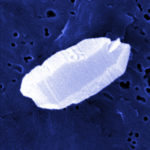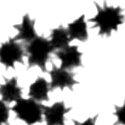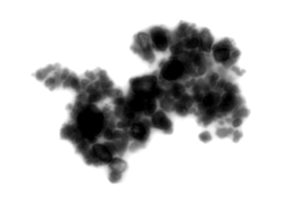Structural studies of subvisible/submicron particles include the analysis of particle structure, of the evolution of their shape, and of the particle behaviour and degradation over time. These characteristics may or may not be evident by the particle size distribution alone. The multiparametric patented SPES, SPES², SPESe, and μDHM technologies and EOS proprietary algorithms allow to identify and get insights on characteristics of samples with a similar size distribution but different optical properties:
- evidence of encapsulation of API and inclusions in delivery systems.
- analysis of capsules and mesoporous particles.
- monitor of the particle aggregation and flocculation.
- study of the evolution of particle degradation, wetting and oversize.
- characterization of particles with non-spherical shape.
PARTICLE SHAPE
 SPES / SPES² provide insights on non-spherical particles. Non-spherical particles in suspension interact differently with the light respect and their effective refractive index is non in agreement with expected on from bulk material. Strange data, artefacts, and non reliable data are thus provided by traditional methods. Thanks to its multiparametric data, SPES / SPES² classify non spherical particles particles with less a priori knowledge on the sample. More information and estimates are possibles.
SPES / SPES² provide insights on non-spherical particles. Non-spherical particles in suspension interact differently with the light respect and their effective refractive index is non in agreement with expected on from bulk material. Strange data, artefacts, and non reliable data are thus provided by traditional methods. Thanks to its multiparametric data, SPES / SPES² classify non spherical particles particles with less a priori knowledge on the sample. More information and estimates are possibles.

Moreover, for metallic materials such as gold, silver, and platinum ones, SPES / SPES² classify particles with different surface shape and roughness, taking advantage of the plasmon surface resonances of these material! Metallic particle of the same size and material but with slightly different shape behave differently and may be separately analysed. Find out how!
INTERNAL STRUCTURE
Structural particle changes and engineering, as mesopourose or core-shell one, inclusions, and adition of layers change the interaction of the resulting particles with the light respect to a spherical compact one made of the reference bulk material. SPES/SPES² exploit the resulting change in the particle effective optical properties and classifies the particles providing added value estimations of:
- core-shell capsules
- particles with API
- particles with inclusions
- mesoporous systems
- particles under degradation
Improve the performance, processability, stability, and appearance of final formulation, as well as product dissolution and absorption rates, and content uniformity!
AGGREGATES
SPES / SPES² monitor and characterize the presence or the formation of particle clusters, flocs, and aggregates thanks to their difference in effective refractive index respect to bulk material and well-dispersed particles. Information on aggregates compactness and size are provided. Take advantage of this unique capability the formulation and analysis of your products: monitor and extend the product shelf life, improve formulation stability in target complex medium/mixture.

